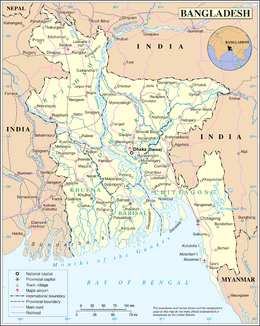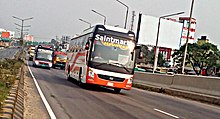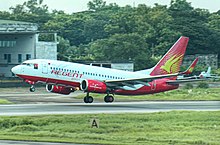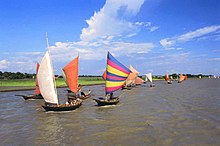| Revision as of 17:35, 5 June 2024 editBolideleoi (talk | contribs)Extended confirmed users581 edits ImagesTag: Visual edit← Previous edit | Revision as of 17:30, 9 June 2024 edit undoBolideleoi (talk | contribs)Extended confirmed users581 edits →Pipelines: expandingTag: Visual editNext edit → | ||
| Line 91: | Line 91: | ||
| == Pipelines == | == Pipelines == | ||
| In 2013, Bangladesh had about {{convert|2950|km}} of ] ].<ref name=":3" /> In 2023, the first cross-border pipeline to import ] products from India was inaugurated, totalling {{Convert|131.57|km}} in length.<ref>{{Cite web |date=2023-03-18 |title=Indo-Bangla Friendship Pipeline inaugurated |url=https://en.prothomalo.com/bangladesh/sqxqtv9f02 |access-date=2024-06-09 |website=Prothom Alo English |language=en}}</ref> In the same year, the first under-sea pipeline to transport ] and ] from a deep-sea ], spanning {{Convert|110|km}}, was commissioned.<ref>{{Cite web |last= |first= |last2= |date=2023-07-03 |title=Country’s first undersea pipeline now in service |url=https://www.thedailystar.net/news/bangladesh/news/countrys-first-undersea-pipeline-now-service-3359511 |access-date=2024-06-09 |website=The Daily Star |language=en}}</ref> | |||
| In 2013, Bangladesh had about {{convert|2950|km}} of natural-gas pipelines.<ref name=factbook>{{cite web|url=https://www.cia.gov/the-world-factbook/countries/bangladesh/|title=CIA World Factbook|access-date=24 January 2018}}</ref><ref>{{cite web|title=Aristocrat Pokies Australia|url=http://www.aristocratpokies.net.au/|access-date=10 June 2015|archive-date=10 June 2015|archive-url=https://web.archive.org/web/20150610085842/http://www.aristocratpokies.net.au/|url-status=dead}}</ref> | |||
| == References == | == References == | ||
Revision as of 17:30, 9 June 2024

| This article needs additional citations for verification. Please help improve this article by adding citations to reliable sources. Unsourced material may be challenged and removed. Find sources: "Transport in Bangladesh" – news · newspapers · books · scholar · JSTOR (March 2024) (Learn how and when to remove this message) |
Since Bangladesh's independence in 1971, the transportation sector has grown rapidly and transportation medium on land and rivers have begun to develop. Air travel came into existence later. Though Bangladesh has greatly evolved in the transportation sector, it still has many flaws which hamper the development of other economic and social sectors. Transportation has evolved in mostly land vehicles but it still needs improvement in safety standards, which endangers the life of civilians.
- Road safety – Ministry of Road Transport and Bridges
- Rail transport – Ministry of Railways
- Civil aviation – Ministry of Civil Aviation and Tourism
- Maritime transport – Ministry of Shipping
Road
See also: List of roads in Bangladesh
With continued economic development, Dhaka (Bangladesh's capital) is beginning to experience severe traffic congestion. This is impacting the quality of life for inhabitants of the metropolitan area, the nation's largest. Many government and public-transport agencies drafted policies, undertook projects and implemented programmes to solve the problem. The Dhaka Integrated Transport Studies, conducted by the Ministry of Planning in 1991–1994, found that the uncoordinated activities of Dhaka City Corporation (DCC), Rajdhani Unnayan Kartripakkha (RAJUK) and the Bangladesh Road Transport Authority (BRTA) did not alleviate the problem and there was no one organisation responsible for improving the city's transport and traffic problems.

With financial assistance from the World Bank, the government of Bangladesh created the Dhaka Transport Coordination Board in 1998. An urban transport plan was commissioned with the US consultant Louis Berger Group and Bangladesh Consultant Ltd (BCL). Introduced in 2008, the comprehensive transport plan—called the Strategic Transport Plan (STP)—for the Greater Dhaka City and its adjoining areas (such as Tongi, Gazipur, Savar, Narayanganj, Keraniganj, Narshingdi and Manikganj) covered around 1,530 square miles (4,000 km). The plan looked at 15 key policy issues, including safety, pedestrian preferences, public transport, non-motorised transport, travel demand management and mass transit systems, and almost 70 policy recommendations were made. Ten comprehensive transport strategies were evaluated, using a baseline of no bus rapid transit (BRT) or metro service, and a number of alternatives were explored. The adopted plan included roads, a three-line metro network (MRT) and three-line BRT. It included provisions for 54 new roads in and around the city, three part-elevated expressways and a circular waterway programme. The previous transportation plan was replaced by the Revised Strategic Transport Plan (RSTP) sanctioned in 2016, which modified the metro network to include five lines and reduced the BRT to two. Additionally, the plan outlined the construction of expressways, including elevated ones, as well as the development of ring roads and radial roads.
Prime Minister Sheikh Hasina inaugurated Bangladesh's highest road, Thanchi-Alikadam Road in Bandarban District, in a 2015 video conference from Dhaka. Construction of the road, which is 2,500 feet (760 m) above sea level, was built under army supervision at a cost of ৳1.17 billion (roughly US$10.8m) and is aiding development, education and health in the hill tracts.
Bangladesh moves up in World Bank logistics index. Bangladesh's rank in the index of countries rose to 88 from 100 in 2018.
Traffic congestion
With more than 250,000 vehicles in Bangladesh and the country's population and infrastructure, traffic congestion wastes fuel and time and makes travel difficult. It also makes existing public transport inefficient, adding unsafe levels of noise and air pollution. Noise and pollution are stressful, and lead to medical conditions such as cardiovascular disease and hypertension.
Traffic congestion varies during the day, necessitating planning and longer trips; this impacts productivity, cutting across social and economic status. Although walking is a major travel mode of the low-income majority, pedestrian needs are ignored in transport planning. As a result of traffic congestion, more people walk and bicycle; however, both may be dangerous. Almost 80 percent of traffic fatalities in Dhaka are pedestrians struck by a fuel-based vehicle. Although private cars are four percent of total vehicles, they occupy about 70 percent of road space. Public transport must be stressed in any future policy. The change to compressed natural gas (CNG) cars saved over 4,000 premature deaths in 2009, but their low cost has increased the number of cars on the roads (although CNG price increases may have tempered the increase) and decreased the amount of natural gas available for other purposes.
Road safety
Passenger's and pedestrian's safety in the roads is currently a burning issue in Bangladesh. Death counts in the highways are rising every day in an alarming rate. Although the government is undertaking a number of significant steps addressing the issue, situations in the highways don't seem to get much positive change too soon. Public unrest and riots demanding safe roads tend to occur in quite an unpredictable manner as both the authority and the highway section of the police prove to fail in bringing discipline in the road transportation system. Alternative ways of mass transit system in public basis have been taken and lots are still undergoing, but the source of all problems is said to lie with untrained drivers and inadequate maintenance of the highways.
Rail
Main article: Bangladesh Railway
Rail transport in Bangladesh comprises railways operated by Bangladesh Railway, and the Dhaka Metro Rail operated by the Dhaka Mass Transit Company Limited.
Rail is as an important method of mass transport in Bangladesh, and many districts are connected by rail. Bangladesh Railway was primarily inherited from the British Assam Bengal Railway system after the partition of India in 1947. Its headquarters is in the southern port city of Chittagong, the south-eastern terminus of the Assam Bengal Railway. After independence from West Pakistan in 1971, only short length of new tracks were laid.
In 2005, the railway was 2,706 kilometres (1,681 mi) long. Of that, 923 km (574 mi) are 5 ft 6 in (1,676 mm) broad gauge tracks (mainly in the western region) and the remaining 1,822 km (1,132 mi) are metre-gauge tracks (mainly in the central and eastern regions). The gauge difference is being addressed by adding third rails to major broad- and metre-gauge routes, making them dual gauge. A road-rail bridge over the Jamuna River opened in 1998 to connect the east and west rail networks.
The border between India and Bangladesh cuts across railway lines, forcing them into the adjacent country for short distances and complicating border controls such as passport validation. After 43 years, the Maitree Express renewed rail transport between Bangladesh and India in 2008; nine years later, Bandhan Express, a second rail service from Kolkata to Khulna began. A third service, the Mitali Express from Siliguri to Dhaka, began in June 2022.
Air
Main articles: List of airlines of Bangladesh and List of airports in Bangladesh
Biman Bangladesh Airlines, the country's national airline, began operation in 1972. Other Bangladeshi-registered passenger airlines are US-Bangla Airlines, Novoair, Air Astra and Fly Dhaka. All five of the carriers have a hub at Shahjalal International Airport, and operate domestic flights, whereas all the afformentioned airlines except Air Astra and Fly Dhaka offer international flights.
Bangladesh has three international airports: Shahjalal International Airport in Dhaka, Shah Amanat International Airport in Chittagong and Osmani International Airport in Sylhet. All three have direct connections to Mideast destinations, and Shahjalal also serves the wider Asian region and Europe. In addition to the international airports, there are five domestic airports: in Barisal, Cox's Bazar, Jessore, Rajshahi and Saidpur. Nearly all service at these airports is to (or from) Dhaka.
Water

Inland waterways
There are approximately 3,600–6,000 kilometres (2,200–3,700 mi) of navigable waterways depending on the season, including up to 3,060 kilometres (1,900 mi) of major cargo routes. In 2009, it was reported that 20 million tonnes of freight and 90 million passengers utilised inland waterways for transportation annually. However, this number has been in decline, particularly following the opening of the Padma Bridge in 2022, which significantly reduced travel time between south-western Bangladesh and the capital, Dhaka, by road and rail. The Bangladesh Inland Water Transport Authority (BIWTA) is responsible for the development, maintenance, and regulation of inland water transport and navigable waterways in Bangladesh.
Ferries
See also: Country boats in BangladeshThe country's extensive river network makes ferries a practical and affordable mode of transport. Passenger ferries, locally referred to as "launches," are widely used to travel to the southern and south-western regions of Bangladesh from the capital. The most popular destinations include Barisal, Bhola, Patuakhali, and Khulna. Additionally, there are water-transport routes connecting Dhaka with Kolkata in India.

Approximately 200 launches operate across 107 water routes throughout the country as of 2022. To support the launch services, the BIWTA has developed 292 wharfs (ghats) for the docking of these vessels, and oversees 380 launch terminals.
There are 53 roll-on/roll-off ferries running on seven routes across the country: Paturia–Daulatdia, Aricha–Kazirhat, Shimulia–Banglabazar, Bhola–Lakshmipur, Lajarhat–Veduria, Char Kalipur–Kalipur Bazar and Harinaghat Chandpur–Shariatpur.
During the rainy season in many areas of Bangladesh, small and medium wooden sailboats and rowboats become the primary means of transportation for people and goods. Among these are the dingi, which is the oldest form of Bengal boat. Larger cargo boats includes vessels such as the balam, bajra and sampan. Under the category of bainkata (flat-bottomed) boats are the ghasi, gachari, dorakha, kathami, mallar, patam and panshi, among others. Ubiquitous throughout Bangladesh, especially in monsoon flood-prone regions, is the kosha, a small, highly manoeuvrable boat that is easy to operate. These various traditional wooden boats play a vital role in providing transportation during the rainy season when other modes become impractical due to flooding.
The ferries are often overloaded and continue to operate in poor weather; many people die each year in ferry and launch accidents. From 2005 to 2015, nearly 1,800 casualties have been reported due to river transport incidents, a number which may be higher due to the prevalence of unregistered vessels. In 2014, the launch Pinak 6 sank in the Padma River with more than 200 passengers aboard near Munshiganj's Louhajang Upazila.
Merchant marine
As of 2023, the country's merchant navy consisted of 558 ships, including 68 bulk carriers, 10 container ships, 170 cargo ships and 162 oil tankers. The Bangladesh Shipping Corporation, a state-owned entity overseeing the management of ocean-going vessels, has seven ships in its fleet, including tanker ships dedicated to transporting oil for Bangladesh Petroleum Corporation and five ships operating on a charter basis for carrying oil, chemicals, and other products.
Ports and harbours
Bangladesh has 22 major river ports used for loading and unloading passengers and goods, as well as for landing motorised marine vessels. These include:
Dhaka, Narayanganj, Barisal, Chandpur, Khulna, Baghabari, Patuakhali, Narsingdi, Aricha, Nagarbari, Daulatdia, Tongi, Maoa, Char Jannat, Ashugonj (Bhairab Bazar), Bhola, Barguna, Noapara, Munshiganj, Chatak, Meghnaghat and Cox's Bazar.
In addition to these major ports, there are 448 small to medium-sized ports throughout the country.
Chittagong is the busiest sea port in Bangladesh, handling 92 per cent of the country's international cargo, followed by Mongla and Payra. The Matarbari Port, under construction, will be the first deep-sea port capable of accommodating large ships by 2026.
Pipelines
In 2013, Bangladesh had about 2,950 kilometres (1,830 mi) of natural gas pipelines. In 2023, the first cross-border pipeline to import petroleum products from India was inaugurated, totalling 131.57 kilometres (81.75 mi) in length. In the same year, the first under-sea pipeline to transport crude oil and diesel from a deep-sea mooring, spanning 110 kilometres (68 mi), was commissioned.
References
- "Baumaschine Ankauf germany provides to Bangladesh". LKW Ankauf. Retrieved 5 May 2015.
- ^ Sunny, Sanwar (2011). Green Buildings, Clean Transport and the Low Carbon Economy: Towards Bangladesh's Vision of a Greener Tomorrow. Germany: LAP Publishers. ISBN 978-3-8465-9333-2.
- Mamun, Shohel (21 September 2016). "Doubt raised about RSTP implementation". Dhaka Tribune. Retrieved 20 March 2024.
- "Bangladesh moves up in World Bank logistics index". www.dhakatribune.com. 27 April 2023. Retrieved 3 May 2023.
- "Lkw verkaufen from Germany". Retrieved 5 May 2015.
- EDITORIAL (25 March 2019). "111 draft recommendations of Road Safety Committee! | Missing the forest for the trees". The Daily Star. Retrieved 9 September 2019.
- Staff-correspondent (2 August 2018). "Dhaka Shaken By Youth Spirit | Thousands take to streets for fourth consecutive day; government orders closure of all schools, colleges today". The Daily Star. Retrieved 9 September 2019.
{{cite news}}:|last=has generic name (help) - Inam Ahmed and Shakhawat Liton (2 August 2018). "SLAY THIS MONSTER". The Daily Star. Retrieved 9 September 2019.
- Staff-correspondent (21 March 2019). "Daylong Protest Over Unsafe Road". The Daily Star. Retrieved 9 September 2019.
{{cite news}}:|last=has generic name (help) - Shubhra Adhikary, Tuhin (29 July 2019). "A Year Since Road Safety Demo: Lofty promises, little action". The Daily Star. Retrieved 9 September 2019.
- "One of the world's most congested cities just opened its first metro line". 29 December 2022.
- Bangladesh's First Urban Railway Opens with Support from Japan, Jiji Press
- "Bangladesh Transport Website FAQ". Archived from the original on 21 August 2020. Retrieved 9 June 2010.
- ^ Alam, AKM Nurul (2012). "Water Transport". In Sirajul Islam; Miah, Sajahan; Khanam, Mahfuza; Ahmed, Sabbir (eds.). Banglapedia: the National Encyclopedia of Bangladesh (Online ed.). Dhaka, Bangladesh: Banglapedia Trust, Asiatic Society of Bangladesh. ISBN 984-32-0576-6. OCLC 52727562. OL 30677644M. Retrieved 9 January 2025.
- ^ Uddin, Md. Imran; Islam, M. Rafiqul; Awal, Zobair Ibn; Newaz, Kazi Md. Shifun (2017). "An Analysis of Accidents in the Inland Waterways of Bangladesh: Lessons from a Decade (2005-2015)". Procedia Engineering. 194: 291–297. doi:10.1016/j.proeng.2017.08.148 – via Elsevier Science Direct.
- ^ "Bangladesh". The World Factbook (2025 ed.). Central Intelligence Agency. Retrieved 3 June 2024.
- ^ Alam, Mahbubul (2012). "Bangladesh Inland Water Transport Authority". In Sirajul Islam; Miah, Sajahan; Khanam, Mahfuza; Ahmed, Sabbir (eds.). Banglapedia: the National Encyclopedia of Bangladesh (Online ed.). Dhaka, Bangladesh: Banglapedia Trust, Asiatic Society of Bangladesh. ISBN 984-32-0576-6. OCLC 52727562. OL 30677644M. Retrieved 9 January 2025.
- "Launches see reduced demand ahead of Eid as people opt for road options". Dhaka Tribune. United News of Bangladesh. 7 April 2024. Retrieved 3 June 2024.
- Haque, Ashraful (17 May 2022). "Utilising waterways: When common home-goers show the way". The Business Standard. Retrieved 3 June 2024.
- Sourav, Md. Mohaimenul Islam; Abeer, Asif Ahmed; Bhuiyan, Abir Hasan (30 April 2024). "Quantifications of service quality factors using the relative importance index method for passenger ferry service in Bangladesh". Discover Civil Engineering. 1 (1): 7. doi:10.1007/s44290-024-00008-8. ISSN 2948-1546.
- Iqbal, Kho Shahriar; Hasegawa, Kazuhiko; Bulian, Gabriele; Karim, Md. Mashud; Ibn Awal, Zobair (October 2007). "Passenger Ferry Accidents in Bangladesh: Design and Socio-economic Aspects" (PDF). 10th International Symposium on Practical Design of Ships and Other Floating Structures. Houston, Texas: American Bureau of Shipping.
...passenger ferries (locally called as "launch")...
- Islam, Nazrul (23 February 2017). "A story of significant progress". The Daily Star. Retrieved 3 June 2024.
- Talukdar, Kamal Hossain (23 June 2022). "River transporters stare into an unknown future as Bangladesh's longest bridge appears". bdnews24.com. Retrieved 3 June 2024.
- Akhter, Shahin; Biswas, Shahjahan (28 October 2021). "Most Bangladesh ferries run without fitness, some after lifespan". New Age. Retrieved 4 June 2024.
- Sarkar, Shihab (28 June 2019). "Country boats: Nation's ever-living emblem". The Financial Express. Retrieved 4 June 2024.
- "Launch sinks in Padma with over 200 passengers". bdnews24.com. 4 August 2014. Retrieved 3 June 2024.
- Islam, Rafiqul; Chowdhury, Shahadat Hossain (17 November 2023). "Shipping Corp embarks on fleet expansion with 21 new vessels". The Business Standard. Retrieved 4 June 2024.
- ^ Nesa, Fazilatun; Khademul Haque, AKM (2012). "River Port". In Sirajul Islam; Miah, Sajahan; Khanam, Mahfuza; Ahmed, Sabbir (eds.). Banglapedia: the National Encyclopedia of Bangladesh (Online ed.). Dhaka, Bangladesh: Banglapedia Trust, Asiatic Society of Bangladesh. ISBN 984-32-0576-6. OCLC 52727562. OL 30677644M. Retrieved 9 January 2025.
- Akhter Hossain, Khandakar (2012). "Sea Port". In Sirajul Islam; Miah, Sajahan; Khanam, Mahfuza; Ahmed, Sabbir (eds.). Banglapedia: the National Encyclopedia of Bangladesh (Online ed.). Dhaka, Bangladesh: Banglapedia Trust, Asiatic Society of Bangladesh. ISBN 984-32-0576-6. OCLC 52727562. OL 30677644M. Retrieved 9 January 2025.
- Hossain, Sohrab (23 March 2023). "Payra port to see larger vessels from April". The Daily Star. Retrieved 3 June 2024.
- "Matarbari deep-sea port to open in 2026". The Daily Star. 17 January 2023. Retrieved 3 June 2024.
- "Indo-Bangla Friendship Pipeline inaugurated". Prothom Alo English. 18 March 2023. Retrieved 9 June 2024.
- "Country's first undersea pipeline now in service". The Daily Star. 3 July 2023. Retrieved 9 June 2024.
| Governance | |
|---|---|
| Currency | |
| Financial services | |
| History | |
| People | |
| By city | |
| Sectors | |
| Regulator | |
| Bangladesh articles | |||||||||||||||
|---|---|---|---|---|---|---|---|---|---|---|---|---|---|---|---|
| History |
| ||||||||||||||
| Geography | |||||||||||||||
| Politics |
| ||||||||||||||
| Economy |
| ||||||||||||||
| Society |
| ||||||||||||||
![]() This article incorporates public domain material from The World Factbook. CIA.
This article incorporates public domain material from The World Factbook. CIA.